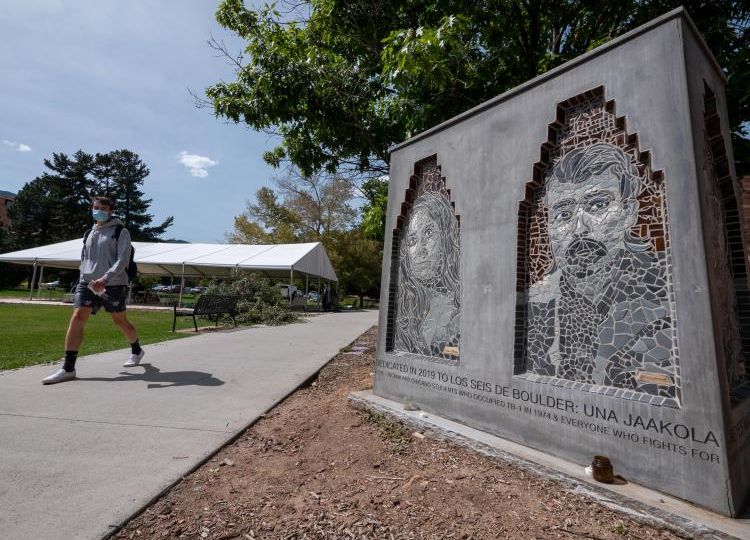
Los Seis Sculpture Remains on CU Boulder’s Campus
Prior to its permanence, the Los Seis sculpture was temporary; Chancellor Philip DiStefano granted permanence on Sept. 16.
On Sept. 16, after many extensions, Chancellor Philip DiStefano granted the Los Seis sculpture, by alumna Jasmine Baetz and surviving family members, a permanent spot on the University of Colorado Boulder’s campus. The sculpture pays tribute to six Chicano activists killed in car bombings in Boulder almost 50 years ago.
Prior to its permanence, the sculpture was temporary. According to campus policy, noncommissioned student or faculty artwork can remain on display for a maximum of 180 days. This policy was created to honor the broad perspectives of the CU community over time. The university announced the sculpture will remain in the University Libraries’ Special Collections Archives.
UMAS y MEXA—a Chinanx and Latinx student group—played a large role in the permanence of the Los Seis sculpture. The activist group works with organizations in the Boulder community to encourage equality and respect. According to UMAS, the students who were killed in 1974 participated in the three-week UMAS occupation, striving for Chicano rights.
“I believe that it is only through the communal preservation of this historical memory that our community was able to come together here, in this time and place, and create a lasting historical monument to commemorate the lives of these students who paved the way for our people to be here, and who demanded better for themselves and their communities from the university,” said Mateo Manuel Vela of UMAS y MEXA in a statement regarding the Los Seis sculptures permanence.
Although the permanence of the sculpture incites celebration, Vela urges discussion around race relations to continue. “We must never forget the labor it takes to create a campus invested–both in word, and in deed–to our success and our futures as Chicanx and Latinx people,” he said.
Cynthia Corral, a sophomore majoring in business, helped circulate a student-created petition to friends in her various social groups. She is a member of the Kappa Alpha Theta sorority on campus, as well as INVST, an Eco-Social justice program and an intern with Public Achievement.
Corral knows the strength the Greek Life community has, so she asked friends and community members to sign the petition. As a student of color, she believes that there is power in numbers and feels the petition is important to showing Chancellor DiStefano that a large student and community group care about the Los Seis sculpture.
“I think it’s stressful because CU claims to be diverse but doesn’t really practice what they preach,” Corral said. “I feel there is a lack of awareness and overall support for people of color on campus.”
After extended deadlines and concern of underrepresentation of the hispanic population on Boulder’s campus, student-created petitions for the art to remain in the community finally reached the Chancellor.
Chancellor DiStefano notes the sculpture’s permanence “will help to provide current and future students, faculty and staff opportunities to learn more about an important chapter of Colorado and university history.”
The premature deaths of the six Chicano activists took place in May of 1974, a time of El Movimiento— also commonly known as The Chicano Civil Rights Movement— a movement which constituted Mexican-American empowerment in the United States. Los Seis de Boulder was a term coined when violent car bombings killed students active in the United Mexican American Students at the University of Colorado Boulder in a quick succession.
As one of Boulder County’s biggest unsolved crime cases, the two identical instances perplexed members of the Latino community, Boulder residents and government investigators.
The explosions occurred during a time of racial tension in Colorado, primarily the cities of Denver and Boulder. The FBI and the local Boulder police department both concluded that the students triggered bombs they had made themselves.
There was speculation about the finding made by the government investigators because it occurred in the peak of the Chicano Movement. Many said that it could have been Chicano-on-Chicano violence that was sparked due to the students’ activism, said Joel Dyer, a former editor for the Boulder Weekly, who has devoted the past 22 years to investigating the deaths.
“I recognize that we must better understand how the events of 1974 connect to the events that are occurring now,” DiStefano said in the press release on Sept. 16. “People will view the Los Seis sculpture in many different ways, and our mission calls for us to preserve the sculpture and use it as a focal point for our community to engage in difficult questions about how the Boulder campus will respond to racism and provide greater equity to students, faculty and staff of color.”
When beginning the creation process, artist Baetz couldn’t believe that there wasn’t already a memorial on campus for the students who died. She created the sculpture to engage people in conversation about what happened, symbolize not just the deaths, but the activists’ lives and provide a place of healing for those involved with the tragedy.
“My hope is that the sculpture’s preservation will weaken our institution’s historical amnesia around civil rights struggles at CU Boulder,” Baetz said.
The sculpture is located outside of Sewall Hall and Temporary Building No. 1.

